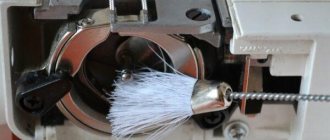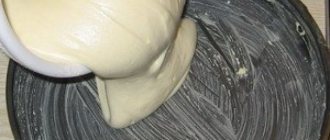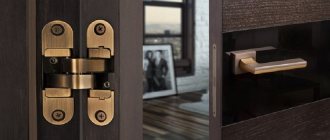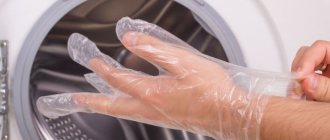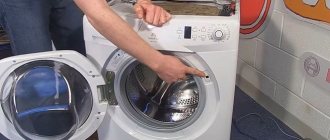Any equipment, mechanism or device needs care and lubrication. In order for your sewing machine to work properly, it must be regularly cleaned, lubricated and stored in appropriate conditions. However, how to clean and store your “swallow”, what oil to choose for sewing equipment and how to correctly and accurately change the oil in a sewing machine are the main issues that this article is devoted to.
What is sewing machine oil?
Sewing machine oil is nothing more than a lubricant that reduces friction and wear on machine elements, covering them with a protective layer, thereby extending their service life. Thus, it is necessary for:
- reducing friction on rubbing elements;
- reducing wear of mechanisms;
- protecting and cleaning components and parts from dust;
- prevent rust.
Where the oil is located in the sewing machine, which parts need lubrication and how often they need to be lubricated are stated in the operating instructions that come with the sewing equipment.
The ingredients of sewing machine oil depend on the raw materials from which it is made. There are the following main groups of oils, differing in their raw materials, which are used to lubricate sewing machines:
- mineral (petroleum) oils - obtained by refining oil, resulting in the formation of a mixture of high-boiling carbons;
- synthetic oils - are produced through the synthesis of chemical elements, as a result of which the presence of mineral fats and solvents is excluded in their composition;
- semi-synthetic oils - are a mixture of petroleum and synthetic oils in a certain proportion.
Features of the lubrication procedure
It is a mistaken belief that when lubricating, you need to apply as much of the compound as possible. This is far from true. Excessive oil may cause further accumulation of dust, pieces of thread and pieces of fabric. The mass, which is formed from lumps of foreign bodies, usually accumulates in one place and leads to the breakdown of a certain mechanism.
Sewing machine lubricant
How often should you lubricate your sewing machine?
There is no universal recommendation on the frequency and method of processing the machine. It all depends on the regularity of its use and the quality of the build. If you use the device several times a week, then it will be enough to change the lubricant a couple of times a year. The processing method is also different everywhere and depends on the structure of the apparatus. The disassembly of devices with a vertical and horizontal shuttle, for example, differs, as does the location of the main components in them.
Sewing tool lubrication
Thus, with high-quality care, as well as compliance with all operating rules, the sewing machine will be able to serve for quite a long time and bring a lot of benefits to its owner.
Source
Lubricant for industrial sewing equipment
Sewing equipment can be domestic or industrial.
Household sewing machines are designed for thin and medium-sized fabrics. It is better not to sew items made of thick and rough fabric with their help. These are mainly mechanical and electromechanical equipment. Such machines are characterized by a drip lubrication system or “dry” lubrication, in which all parts are filled with oil and operate for a certain time without additional lubrication.
Industrial sewing machines are electronic devices with microprocessors and program control. Such machines are divided into classes depending on what fabrics they can process: light and medium fabrics, medium and heavy fabrics, and especially heavy fabrics.
The latest industrial machines are equipped with an automatic lubrication system, thanks to which lubricant is supplied through special channels to mechanisms subject to friction. Since the computer itself determines the frequency and required volumes of lubricant, the sewing machine has a special reservoir (crankcase) for storing oil. The crankcase has marks indicating the oil level. The whole job of lubricating such machines is to watch the mark and replenish the reservoir in time.
Some industrial sewing machines, like household ones, are lubricated using a drip lubrication system or a “dry” method, in which the main rubbing parts and mechanisms are made of special materials with a reduced friction coefficient and lubricated with a special substance. Such machines must be serviced by professionals.
Both types of sewing machines can be treated with both mineral and synthetic oil. The recommended type of lubricant for a specific equipment is indicated in the instructions for its use. Let's look at how the two types of oil differ from each other.
Synthetic sewing machine oil has a number of advantages:
- the viscosity of synthetic oil does not change over a wide temperature range: from -40°C to 200°C;
- such oil is more fluid than petroleum oil and its penetrating properties are higher;
- does not contain mineral fats or solvents;
- necessary for lubricating and adding shine to plastic and elastomeric surfaces;
- prevents threads from sticking and twisting, reducing the number of thread breaks;
- breaks down in a large number of solvents;
- not oily, not rancid;
- protects your machine from corrosion and oxidation processes.
Among synthetic oils for sewing machines, silicone oils are especially popular. This type of oil is suitable for oiling threads, blades, knives, all parts and assemblies, rubber and plastic elements. Treatment is carried out using a brush or spray.
Mineral (petroleum) oil. Among mineral oils, the most popular is vaseline (white paraffin) oil - this is a transparent, purified solution of liquid saturated hydrocarbons. It has a watery white color and is practically odorless because it does not contain aromatic compounds. Particularly in demand for mechanisms requiring high purity of lubricants.
This type of oil is well suited for sewing machines and overlockers, since it is easily washed off upon contact with fabric. Vaseline oil can be used both for industrial sewing and “amateur” sewing machines, and for various types of knives, blades, rubber and plastic elements and parts of knitting machines. This oil can also be used to eliminate jammed zippers in clothes.
Main characteristics of vaseline oils:
- colorless, tasteless and odorless;
- does not contain harmful and toxic substances, therefore it is safe when touching food;
- has an antistatic effect;
- improves the sliding process and protects elements from sticking together;
- does not leave greasy marks;
- the oils do not contain solvents;
- protects against corrosion.
The characteristics of synthetic and mineral oils are similar and are used for the same purposes. However, the cost of synthetic oil is significantly higher than mineral oil.
Podolsk 132
The model specializes in working with synthetics, silk, linen and wool.
Stitches you can sew with:
- Straight
- Zigzag
Also, “Podolsk-132” with a foot drive can embroider and darn. It is possible to use both single-core and double-core needles.
List of threads approved for use:
- 1 tex x 3 (No. 30);
- 16.5 tex x3 (No. 40);
- 13 tex x 3 (No. 50);
- 10 tex x 3 (No. 60);
- 7T5 tex x 3 (No. 80) GOST 6309-73;
- Threads made of natural twisted silk No. 65 according to GOST 22665-77
Advantages: reliable, durable, easy to learn;
Disadvantages: heavy, takes up a lot of space.
Which one is better?
The choice of special sewing oils is very diverse. There are many manufacturers on the market that offer oils of various properties, price ranges and qualities. Main characteristics that should be considered when choosing oil for sewing equipment:
- degree of cleaning - clean and transparent lubricant does not cause sticking of elements and is not left on the fabric;
- viscosity - reflects the degree of strength of the oil film on lubricated mechanisms. The viscosity of oil for a sewing machine in the best value is 18-20 cSt (mm›/s);
- pour point and ignition temperature;
- chemical stability - the ability not to oxidize or deteriorate under the influence of external forces and the interaction of oil with metal parts and various fabrics;
- cleaning properties - the ability to wash away particles of dust and debris;
- the presence of additives and additives that can improve the properties of the oil.
Everyone chooses a lubricant according to their taste and wallet. However, it is worth noting that the consumption of high-quality oil is not high - one jar will last for a couple of years, since such oil does not spoil.
In many forums dedicated to the topic of sewing machines or simply sewing and needlework, among the advice of visitors there are various alternatives to oil for sewing machines.
Some advise saving money and not spending money on sewing oil and taking what you have at home or in the garage, for example, car oil. Others advise using vegetable oils like sunflower or olive.
However, do not try to follow such advice and risk your equipment! The viscosity of automobile and sewing oils is not the same, which can lead to jamming of the sewing machine, and then cleaning all mechanisms from inappropriate oil will require a lot of labor, time and money.
The same applies to ordinary vegetable oils - sunflower, olive or any other that you have at home https://holz-house.ru/. These oils are suitable for consumption, but not for lubrication of sewing equipment. At first it may seem to you that the machine is working perfectly, but then this oil will turn into glue, all the mechanisms will stick together, and the machine will simply stop functioning.
Also, you should not use dark and cloudy oil lying around, even sewing oil. Its action is similar to that of automobile and vegetable oil. You can spoil the machine in no time, but then returning it to working condition is already a problem.
Story
In the 19th century, Georg Neidlinger, a European agent of the Singer company, proposed establishing the production of sewing machines in Russia. The plant, under the leadership of Walter Frank Dixon, was built quickly. Provincial Podolsk had a lot of cheap land and labor. The German concern, expanding the production of sewing equipment, opened a plant in Podolsk in 1902.
By 1913, the Podolsk enterprise produced 600,000 cars per year. This is 2500 products per day. They were sold throughout the Russian Empire, were not inferior in quality to imported devices, and were sold in installments for poor people. A network of branded stores was deployed throughout the country.
After the revolution, the enterprise was nationalized, but, despite the severance of relations with the “head office,” the production of equipment did not stop. Only 77 years later, in 1994, Singer resumed cooperation with the Podolsk representative office.
Models
Oil for Juki
The best oil for a sewing machine is the one that comes with it. That's why Juki sewing machine oil is sold with it. However, the same oil can be purchased separately or ordered through official representatives of the company.
Oil for a Bernina sewing machine, as well as oil for a Janome sewing machine, cannot be found on the open market. Therefore, if for some reason there is no “native” oil, you need to purchase a special oil for the sewing machine, which should be fluid and transparent. The types of oils and their properties have been described above.
The oil can or jar into which the oil is poured must also meet the quality requirements - good plastic without flaws, indicating the country of production. The oiler should be ergonomic.
To prevent dust and debris from getting into it, the lid or cap must be tightly closed. The tip of the oiler should be long enough and not too wide to reach hard-to-reach places. It is logical that the oiler should not be large, because it will be inconvenient to use.
Podolsk 2m
The most common device in the Russian Federation is a simple machine with a manual drive, sometimes with a foot pedal; for a long time it was almost the only running car in Russia. You can still see such manually driven examples in school workshops.
Advantages: in terms of power characteristics, it is not inferior to modern electronic analogues. Thick fabrics are sewn neatly and securely.
Disadvantages: limited range of actions. You can only do the simplest operations.
Do-it-yourself repair and adjustment of the Podolsk sewing machine
How to find out the year of manufacture
The year of production, with a probability of more than 90 percent, is between 1960 and 1980, since the lion's share of PMZ machine units was produced at that time. They are all standard and practically no different (all parts fit together).
Functionality check
If you get your hands on a copy of the machine (and you can’t find others now - only if someone carefully stored it for several decades in ideal conditions), first of all you need to:
- Check the shuttle stroke (cleaning the compartment from fringes is simply a necessary measure);
- Remove all moving parts that can be removed (including the needle plate and main cover);
- Using a rag or a special brush (with soft metal bristles), walk along the teeth, rotation grooves (where the most dirt accumulates due to oil/solid) and along the bobbin case;
- No matter how anecdotal it may sound, try to make sure that after reassembling the machine you do not have any extra parts left. The peculiarity of the products of the Podolsk factory is that they simply do not have unnecessary parts.
How to place the needle
Many novice seamstresses can “cut off” at this point and consider that the machine is irreparably broken and cannot be repaired - it often turns out that the needle is simply placed in it incorrectly.
The schematic diagram shows how everything should look:
Lubrication of central components
It is important to follow two rules:
- Do not forget about hard-to-reach places - connecting joints, unnoticeable grooves, hinges. The main components - the shaft, the drive - almost always have holes into which you can drop special oil. GOST for oils is described in the instructions;
- The external, visible part of the device needs lubrication just as much as the internal one - this greatly improves the appearance of the machine. Try not to oil the areas where the fabric will later be placed, so that you don’t have to throw it away due to greasy stains.
Adjusting the machine Podolsk. Needle bar features
From time to time, when working with coarse fabric, the following happens - due to the specifics of the material, the needle bar moves up and the sewing line begins to be interrupted. To prevent this, you need to change the position of the needle. This is done as follows:
- The adjusting screw for fastening the needle bar is located inside the front compartment housing, and access to it is possible only through a special hole. You won't be able to see the screw, but you can feel the slots with a short flathead screwdriver. The screw is located on the right side of the machine, and you only need to loosen it, but under no circumstances completely unscrew it! It will be much more difficult to insert it back.
- By turning the handwheel, bring the nose of the hook to the needle and adjust the position of the needle so that at the moment the nose of the hook and the needle meet, it passes with the lower edge above the eye of the needle by 1.5 - 1.8 mm. After setting this position, tighten the needle bar screw tightly.
